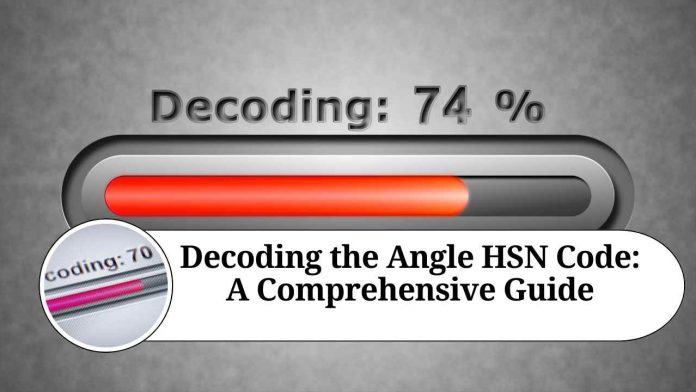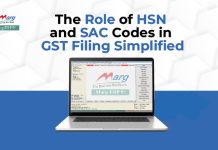Introduction
In the world of international trade and commerce, the Harmonized System of Nomenclature (HSN) plays a crucial role in classifying goods and facilitating smooth cross-border transactions. One specific category within the HSN code system is angles, which are widely used in various industries for structural and engineering purposes. In this blog, we will delve into the intricacies of the Angle HSN Code and explore its significance in global trade.
Understanding the HSN Code: The Harmonized System of Nomenclature (HSN) is an internationally recognized standard for classifying products in a consistent and systematic manner. It was developed by the World Customs Organization (WCO) to harmonize product classification and facilitate international trade. The HSN code comprises a series of numbers assigned to specific goods, providing a standardized way to identify and classify products across borders.
Angle HSN Code: Within the HSN system, angles are categorized under Chapter 72, which covers iron and steel products. More specifically, angles fall under subheading 7216, which encompasses L and T sections, as well as other angles and shapes of iron or non-alloy steel. The Angle HSN Code is 7216 and serves as a unique identifier for angles in international trade.
Importance of Angle HSN Code: The Angle HSN Code is essential for several reasons:
- International Trade: The Angle HSN Code ensures uniformity in product classification across different countries, enabling seamless international trade. Importers and exporters can accurately identify and classify angle products using the code, facilitating efficient customs clearance and reducing trade barriers.
- Tariffs and Duties: The Angle HSN Code plays a vital role in determining the applicable tariffs, customs duties, and taxes for angle products. Each HSN code corresponds to specific tariff rates and trade policies, allowing governments to impose the appropriate duties on imports and exports. Importers and exporters need to be aware of the Angle HSN Code to comply with customs regulations and calculate the associated costs accurately.
- Statistical Data: The Angle HSN Code helps in collecting and analyzing trade statistics at a global level. Governments and international organizations utilize this data to monitor trade flows, assess market trends, and make informed policy decisions. The code enables the compilation of accurate and comprehensive trade data specific to angle products, aiding in economic analysis and forecasting.
- Market Research: Businesses and market researchers can leverage the Angle HSN Code to gather insights into the angle product market. By examining trade data associated with the code, they can identify key import and export markets, analyze competition, and make informed business decisions. The Angle HSN Code serves as a valuable tool for conducting market research and understanding global trade dynamics related to angles.
Conclusion
The Angle HSN Code, classified under Chapter 72 and specifically denoted as 7216, is a crucial component of the Harmonized System of Nomenclature. It plays a vital role in classifying angles accurately, facilitating international trade, determining tariffs and duties, and collecting trade statistics. Importers, exporters, and businesses involved in the angle industry should be well-versed in the Angle HSN Code to ensure compliance, streamline customs procedures, and make informed market decisions. By understanding the Angle HSN Code and its significance, stakeholders can navigate the complexities of global trade more effectively.
Other Related Blogs: Section 144B Income Tax Act
Frquently Ask Question
Q1: What is an HSN code?
A1: The Harmonized System of Nomenclature (HSN) code is an internationally recognized system for classifying products. It consists of a series of numbers assigned to specific goods to provide a standardized method of identifying and categorizing products in international trade.
Q2: What is the Angle HSN Code?
A2: The Angle HSN Code is 7216. It falls under Chapter 72 of the HSN system, which covers iron and steel products. Specifically, the Angle HSN Code is used to classify L and T sections, as well as other angles and shapes made from iron or non-alloy steel.
Q3: Why is the Angle HSN Code important in international trade?
A3: The Angle HSN Code is crucial for several reasons. It ensures uniformity in product classification across different countries, facilitates efficient customs clearance, helps determine applicable tariffs and duties, enables the collection of accurate trade statistics, and aids in market research and analysis.
Q4: How can I find the Angle HSN Code for a specific angle product?
A4: You can find the Angle HSN Code by referring to the HSN code list or consulting customs authorities in your country. The HSN code list is available online and provides detailed classifications for various goods, including angles.
Q5: Are there different HSN codes for different types of angles?
A5: No, the Angle HSN Code (7216) encompasses various types of angles, including L and T sections and other angles made from iron or non-alloy steel. The code is not specific to any particular type of angle.
Q6: Can the Angle HSN Code change over time?
A6: The HSN code system is periodically updated to accommodate changes in product classifications. It is essential to stay updated with the latest version of the HSN code list to ensure accurate classification and compliance with customs regulations.
Q7: How is the Angle HSN Code used in customs procedures?
A7: When importing or exporting angle products, the Angle HSN Code is used to accurately classify the goods on customs documents. It helps customs authorities identify the nature of the product, determine applicable duties and taxes, and ensure compliance with trade regulations.
Q8: Can the Angle HSN Code be used for domestic trade within a country?
A8: While the HSN code system was primarily developed for international trade, some countries also adopt the HSN codes for domestic trade purposes. However, it is essential to consult the specific customs regulations and guidelines of your country to determine the applicability of the Angle HSN Code in domestic trade.
Q9: Are there any other codes related to angles apart from the HSN code?
A9: Depending on the country and specific industry, there may be additional codes or standards used to classify angles. For example, in the United States, the American Standard for Testing and Materials (ASTM) designations are commonly used to specify different types of angles.
Q10: How can I ensure the accuracy of the Angle HSN Code for my angle products?
A10: It is advisable to consult with customs authorities, trade associations, or professional experts familiar with the HSN system and angle products to ensure the accurate classification and proper use of the Angle HSN Code. Regularly updating your knowledge on trade regulations and staying informed about any changes in the HSN code list is also important.




















